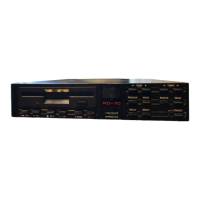ThewordMIDIisanabbreviationforMusicalInstrumentDigitalInterface.
The MIDI language was originally designed by NASA for scientific purposes,
and it is only since 1983 that it has been successfully applied to musical
instruments.
It is basically a code which can convert any parameter of real musical
performance into a series of messages which can then be transmitted, by
meansofaspecialinterfaceandcables,toanexternaldeviceequippedwitha
MIDIinterfacewhich is able todecodethemessagesandreconvert them into
musicalsounds.
The MIDI code is now universally used by all musical instrument
manufacturers as it minimizes incompatibility between different brands and
models, enabling them to communicate without problems. Communication
takes place through a maximum of 16 separate transmit/receive channels
(similar in principle to TV channels) allowing for simultaneous control of at
least 16 different instrumental parts, each with completely independent
pitch,dynamics,volume,etc.
Threetypesofconnectionareusedfordatacommunication:
MIDIIN:receivesmessagesfromanexternaldevicewhichgeneratesthem.
MIDI OUT: transmits messages generated by the device on which it is
installed.
MIDITHRU:re-transmits messagesreceivedatMIDIINwithoutalteringthem
inanyway.
TheStandardMIDIFileisanencodingformatforMIDIdataandisnotaffected
bythetypeofdatacontainedorthetype ofsound source. Itisbasicallyaway
of ensuring compatibility between recordings made by different devices
(suchassequencers,computers,etc.).
TherearetwotypesofMIDIFILE:0and1.
Format 0 is also known as the single-track format because it stores the MIDI
data on a single track containing all of the information about the recorded
instrumentalparts. The partsareonly separatedbytheMIDIchannelthrough
whichtheyarereproduced.
Format 1 is also known as the multi-track format because it maintains the
division of the instrumental parts on separate tracks when storing the
messages(ifdivisionhasbeenusedattherecordingstage).
1.3MIDI Code
1.4 Standard MIDI File
INTRODUCTION
MIDI can separately control
up to 16 independent sound sources.
A MIDI connector.
MIDI OUT
14
9
10 11
12
13
14
15
16
5
6
7
8
23
MIDI IN
MIDI THRU
MIDI IN

